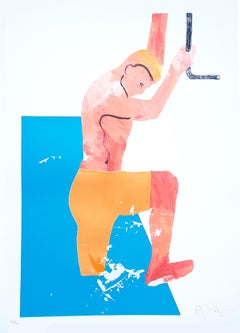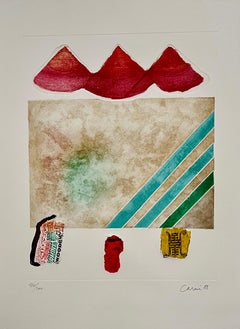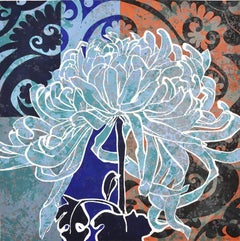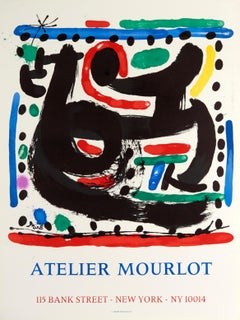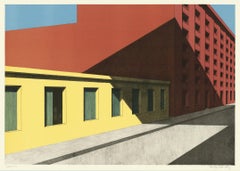Medium More Prints
to
313
2,331
1,729
2,291
974
771
Overall Width
to
Overall Height
to
627
344
272
257
225
34
23
21
17
11
9
6
4
241
203
125
42
27
27
40
1,305
919
2
31
8
18
66
55
159
488
183
101
17
1,334
677
273
53
37
32
25
21
18
17
14
10
9
7
6
6
5
5
5
5
4
4
4
863
635
463
455
452
500
502
1,186
1,055
Size: Medium
Gavin Dobson, Dipping Ricky, Contemporary Art, Affordable Art, Summer Art
By Gavin Dobson
Located in Deddington, GB
Gavin Dobson
Dipping Ricky
Limited Edition Screen Print
Edition of 50
Sheet Size: H 70cm x W 50cm x D 0.1cm
Sold Unframed
(Please note that in situ images are purely an indication of...
Category
21st Century and Contemporary Contemporary Figurative Prints
Materials
Paper, Screen
Italian Abstract Aquatint Collage Lithograph Print Eugenio Carmi 80s Memphis Era
Located in Surfside, FL
Genre: Modern, Modernist
Subject: Abstract
Medium: Print, Aquatint
Hand signed dated 1988, limited edition
Surface: Paper
Country: Italy
Dimensions: 26" x 20" approximately
Eugenio ...
Category
1980s Post-Modern Abstract Prints
Materials
Aquatint
Fire Opal
Located in Lyons, CO
Color lithograph, Edition 30
Kushner has collaborated with Master printer Bud Shark since 1982 on various monotypes and lithographs. These exuberant, sensuous prints often include...
Category
21st Century and Contemporary Contemporary More Prints
Materials
Lithograph
Atelier Mourlot Bank Street by Joan Miro - colorful abstract original lithograph
By Joan Miró
Located in New York, NY
This colorful abstract original lithograph was printed in 1967 at the Atelier Mourlot in NYC. When The Mourlot Studio decided to open a branch in New York City, after a successful ex...
Category
1960s Abstract Expressionist Abstract Prints
Materials
Lithograph
Shadow of the Brooklyn Bridge.
Located in New York, NY
“THE SHADOW OF THE BROOKLYN BRIDGE”
Emilio Sanchez (1921-1999) created this color lithograph entitled “Shadow of the Brooklyn Bridge” in 1988. The image size is 21.38 x 30.50 inche...
Category
Late 20th Century American Modern Landscape Prints
Materials
Lithograph
New York City Plaza (Plaza Fountain)
Located in Hollywood, FL
ARTIST: Salvador Dali
TITLE: New York City Plaza (Plaza Fountain)
MEDIUM: Etching
SIGNED: Hand Signed
EDITION NUMBER: 101/125
MEASUREMENTS: 30" x 22"
YEAR: 1964
FRAMED: No
C...
Category
1960s Surrealist More Prints
Materials
Etching
Les Songes Drôlatiques de Pantagruel, Planche XI
Located in OPOLE, PL
Salvador Dali (1904-1989) - Les Songes Drôlatiques de Pantagruel, Planche XI
Lithograph from 1973.
Edition 6/250 on Japon paper.
Dimensions of work: 76 x 56 cm
Publisher: Carpent...
Category
1970s Surrealist More Prints
Materials
Lithograph
Dalinean Horses The Centaur of Crete
Located in Hollywood, FL
ARTIST: Salvador Dali
TITLE: Dalinean Horses The Centaur of Crete
MEDIUM: Lithograph
SIGNED: Hand Signed
PUBLISHER: Simeon Wajntraub & Jacques Carpentier
EDITION NUMBER: 170/25...
Category
1970s Surrealist More Prints
Materials
Lithograph
Fouquier-Tinville
Located in OPOLE, PL
Bernard Buffet (1928-1999) - Fouquier-Tinville
Lithograph from 1977.
The edition of 103/150.
On Arches paper with watermark.
Dimensions of work: 76 x 56 cm.
Hand signed.
The wor...
Category
1970s Expressionist More Prints
Materials
Lithograph
Indiarum Occidentalium Tractus Littorales cum Insulis Caribicis / Pascaert van W
By Louis Renard
Located in New York, NY
This early 18th-century engraved map was published by Louis Renard in Amsterdam. The image size is 19 x 22 " (48.3 x 55.9 cm) plus margins.
A beautifully engraved Dutch sea chart. Shown is the entire Caribbean basin including the eastern seaboard up to Cape Cod and includes Bermuda. Florida is shown with the classic flattened southeastern coast that was derived by Hessel Gerritz. Noted are the routes taken by the Spanish treasure...
Category
18th Century Other Art Style More Prints
Materials
Engraving
Midcentury Modern Villa Architecture
Located in Columbia, MO
Midcentury Modern Villa Architecture
c. 1950
Architectural print "Elevation AA"
Unknown edition
19 x 25.25 inches
Category
Mid-20th Century Modern More Prints
Materials
Pigment
Abstract Landscape Rajasthan Light Viscosity Print Natural Seasons Earth Blue
Located in Norfolk, GB
There is a natural and raw understanding in Mukesh Sharma’s prints that depict, and are influenced by, the Rajastani communities of his home town in rural India. In these Limited Edi...
Category
1990s Abstract Abstract Prints
Materials
Archival Ink, Archival Paper, Archival Pigment
WATER Signed Lithograph, Abstract Utility Man Hole Cover, Aqua, Orange, Beige
Located in Union City, NJ
WATER is an original hand drawn lithograph created by Pierre Alechinsky in 1985, printed using hand lithography techniques on Arches paper, 100% acid free. WATER is an abstract design exemplifying Alechinsky's expertise as a master printmaker with his use of expressive loose brushwork and fluid abstract lithographic washes that surround an imprint which reads "WATER" taken from an actual wax crayon rubbing of a NYC public water utility manhole cover...
Category
1980s Abstract Abstract Prints
Materials
Lithograph
Helen Fay, Brodie Standing, Limited Edition Print, Dog Art, Affordable Art
Located in Deddington, GB
Brodie Standing [08]
Limited Edition
Etching , hand printed on Hanemulle etching paper
Edition of 75
Image size: H:30.5 cm x W:51 cm
Complete Size of Unframed Work: H:45 cm x W:64 cm x D:.15cm
Sold Unframed
Please note that insitu images are purely an indication of how a piece may look
N.B. Original Print, handmade and hand printed etching. An old friend of mine, Brodie the Scottish Terrier. He was a regular at the shows and a wonderful character.
Animals have always been at the heart of my work. I find the form, movement and behaviour of the creatures I draw a source of limitless fascination. I love the idea of them watching me, watching them as I draw. I hope my appreciation of the sentience and character of the animals I draw comes across in my work. Over my career I have drawn everything from primates to penguins, dogs, ostriches and even an echidna. These days dogs are my main focus, mostly because I adore dogs but also because they are such an integral part of life. I am delighted by the theory that humans and dogs co evolved, we wouldn’t be what we are without them and vice versa. I try to pare my images down to a balanced simplicity that directs attention to the subject of the picture. I try to balance the subject and the space it occupies, giving each equal importance. Light is hugely important to my work, I imagine my subject in three dimensions as I draw and the light describes the musculature and texture that gives the drawing it’s presence and grounds it in the picture. I aim to capture a pause, a moment where whatever I draw looks like it could wander off or leap up any minute. My influences include Japanese prints, Chinese and Japanese brush drawing and the European artists who were influenced by Japan. I am really excited by composition, by artists like Bonnard and Leon Spilliaert...
Category
21st Century and Contemporary Contemporary Animal Prints
Materials
Paper, Etching
Paper Lanterns
By David Salle
Located in New York, NY
Three-color solar plate intaglio on Somerset paper (Edition of 75 + 15 APs)
Signed, dated, and numbered in pencil, recto
30 x 22 inches, sheet
16 x 10.75 inches, image
This artwork...
Category
1990s Contemporary More Prints
Materials
Intaglio
Abstract Landscape Indian artist Natural Pigments Australia Earth Brown Blue
Located in Norfolk, GB
There is a natural and raw understanding in Mukesh Sharma’s prints that depict, and are influenced by, the Rajastani communities of his home town in rura...
Category
Early 2000s Abstract Abstract Prints
Materials
Paper, Printer's Ink, Pigment
Vintage Jim Dine poster Boymans Museum (Two Ties) red black 1970s retro pop art
By Jim Dine
Located in New York, NY
Original poster produced on the occasion of Jim Dine's 1971 exhibition at the Boymans Museum, Rotterdam. This vintage poster reproduces the artist’s lithograph Two Ties: neckties ske...
Category
1970s Pop Art Figurative Prints
Materials
Offset
Tulipe (I), Screenprint (lamé) Limited Edition of 60 by Yayoi Kusama (ABE 290)
By Yayoi Kusama
Located in Hong Kong, HK
Yayoi Kusama
Tulipe (I), A.P. from the Edition of 60.
Screenprint [8 screens, 8 colors, 11 runs].
Lamé [3 colors]
Image: 45.5 x 38 cm.
Sheet: 65x 50 cm.
Provenance:
Ravenel Art Auct...
Category
Early 2000s Pop Art Still-life Prints
Materials
Screen
Exhibition Poster Galerie Gerald Cramer - Lithograph by Joan Mirò - 1969
By Joan Miró
Located in Roma, IT
Exhibition Poster Galerie Gerald Cramer is a contemporary artwork realized by Joan Mirò.
Mixed colored lithograph.
The poster was realized in occasion of the exhibition of the arti...
Category
1960s Surrealist More Prints
Materials
Lithograph
Impressions of Africa - Mandela, Former South African President, Signed Artwork
Located in Knowle Lane, Cranleigh
Nelson Mandela, Impressions of Africa (black and white), Signed Limited Edition Lithograph
Many people are unaware that Nelson Mandela turned his hand to art in his 80's as a way of ...
Category
Early 2000s Contemporary Figurative Prints
Materials
Lithograph
Moon Shell, Lithograph by Jill O'Connell
Located in Long Island City, NY
Moon Shell
Jill O’Connell
Date: circa 1980
Lithograph, signed and numbered in pencil
Edition of 500, AP
Image Size: 24.5 x 19 inches
Size: 29.5 in. x 23 in....
Category
1980s More Prints
Materials
Lithograph
Trees
Located in San Francisco, CA
This artwork "Trees " c.1990 in an original monotype on B.F.K Rives paper by American artist Kelly Detweiler. It is hand signed, titled and numbered 1/1 in pencil by the artist. The image size is 17.85 x 15.65 inches, sheet size is 24.25 x 22.25 inches. It is in excellent condition, the colors are fresh and bright, has never been framed.
About the artist:
Born in Twin Falls Idaho, his family immediately moved to Monte Vista, Colorado where he lived until age 12. Many of the idyllic memories of this childhood inform his imagination and enter into his work. Moving from a very small farming and ranching community, he was plunged into the crazed consumer culture of Southern California. He lived in La Mesa, California and watched as the entire face of America changed with Vietnam, rampant divorce, and then the summer of love. He attended Grossmont College and immersed himself in art. Seeking to escape the drug crazed beach culture, he set out for northern California.
Kelly attended Cal State University at Hayward where he studied with Mel Ramos, Raymond Saunders, Harold Schlotzhauer, Misch Kohn, Kenji Nanao and Clayton Bailey...
Category
Late 20th Century American Modern More Prints
Materials
Monotype
Matthew (Geoffrey of Monmouth)
Located in Washington, DC
Artist: Salvador Dali
Title: Matthew (Geoffrey of Monmouth)
Portfolio: 1972 The Twelve Apostles (Knights of the Round Table)
Medium: Lithograph
Year: 1972
Edition: 41/350
Frame Size:...
Category
1970s Surrealist Portrait Prints
Materials
Lithograph
Hommage aux Petits Lits Blancs
Located in Hollywood, FL
ARTIST: Salvador Dali
TITLE:Hommage aux Petites Lits Blancs
MEDIUM: Lithograph done for Wally Findlay Gallery
SIGNED: Hand Signed
PRINTER: Mourlot Printers
EDITION NUMBER: 87/2...
Category
1970s Surrealist More Prints
Materials
Lithograph
Fight the Power
By Ben Eine
Located in London, GB
6 colour screen print on 300 gsm Somerset Satin, with hand-deckle edges
Edition of 50
50 x 70 cm
hand-signed and numbered by the artist
Ben Eine is a prominent British street artist...
Category
2010s Street Art More Prints
Materials
Screen
I am the Moth, You are the Flame
Located in London, GB
David Shrigley
I am the Moth, You are the Flame, 2022
Linocut on Somerset Tub Sized 300gsm paper
Signed by the artist and numbered
65 x 50 cm (25 5/8 x 19 3/4 in)
Edition 23 of 100
...
Category
2010s Contemporary Animal Prints
Materials
Linocut
Andrew (Visions of Camelot)
Located in Washington, DC
Artist: Salvador Dali
Title: Andrew (Visions of Camelot)
Portfolio: 1972 The Twelve Apostles (Knights of the Round Table)
Medium: Lithograph
Year: 1972
Edition: 41/350
Frame Size: 29...
Category
1970s Surrealist Portrait Prints
Materials
Lithograph
Sill Life - Original Lithograph by Ivo Pannaggi - 1975 ca.
By Ivo Pannaggi
Located in Roma, IT
Image dimensions: 54 x 40 cm.
Still Life is a beautiful and rare lithograph realized by the artist Ivo Pannaggi in a circulation of 100 copies around 197...
Category
1970s Futurist More Prints
Materials
Lithograph
Musée Cantini lithographic poster by Fernand Leger, 1966
Located in New York, NY
This lithographic poster was printed in 1966 at the Atelier Mourlot in Paris to promote an exhibition of Leger's works at the Musée Cantini in Marseille in the summer of 1966. Leger ...
Category
1960s Abstract Abstract Prints
Materials
Lithograph
Greville Smyth Pine, Limited edition print, Landscape, Tree, Nature art
Located in Deddington, GB
A very detailed drypoint etching of a Pine tree printed onto gampi Japanese tissue and backed onto Hahnemule printmaking paper. This print considers how we view the contemporary sublime landscape and how easy it can be to experience when we take the time to look. We often don’t have to travel far: parks in cities, the coastline and stars in the night sky. The mature Scots Pine tree pictured...
Category
2010s Contemporary Landscape Prints
Materials
Drypoint, Etching
Jadé Fadojutimi, A Season’s Echo - Signed Print, British Art, Abstract Art
Located in Hamburg, DE
Jadé Fadojutimi (British, b. 1993)
A Season’s Echo, 2022
Medium: Lithograph on paper
Dimensions: 65.7 × 48.1 cm (25 9/10 × 18 9/10 in)
Edition of 50 + 7AP: Hand-signed and numbered
C...
Category
21st Century and Contemporary Abstract Abstract Prints
Materials
Lithograph
Memories of Surrealism Surrealist Portrait of Dali Surrounded by Butterflies
Located in Hollywood, FL
ARTIST: Salvador Dali
TITLE: Memories of Surrealism Surrealist Portrait of Dali Surrounded by Butterflies
MEDIUM: Etching on Japon Paper
SIGNED: Hand Signed by Salvador Dali
EDIT...
Category
1970s Surrealist More Prints
Materials
Etching
God Save the Green I, Limited Edition Rabbit Print, Blue Animal Artwork
By Harry Bunce
Located in Deddington, GB
God Save the Green by Artist Harry Bunce is a limited edition print. An expressionistic piece, depicting a rabbit with the caption above 'God Save the Green'.
Harry Bunce artist wit...
Category
2010s Pop Art Animal Prints
Materials
Archival Paper, Screen
Composition en jaune, noir et rouge
By Chu Teh-Chun
Located in OPOLE, PL
Chu Teh-Chun (1920-2014) - Composition en jaune, noir et rouge
Lithograph from 2000.
Edition 22/80.
Dimensions of work: 75 x 53.5 cm.
Hand signed.
The work is in Excellent condi...
Category
Early 2000s Modern More Prints
Materials
Lithograph
$3,286 Sale Price
20% Off
Bridge
Located in San Francisco, CA
This artwork titled "Bridge" 1980 is an original color serigraph by American artist Darryl Sapien, b.1950. It is hand signed, dated and numbered 10/31 in pencil by the artist. The sheet size is 28.25 x 21.85 inches, framed size is 30 x 23.65 inches. It is framed in a black metal frame. The artwork is in excellent condition, the frame has minor scratches.
About the artist:
Selected exhibitions.
San Francisco Art Institute, B.F.A., Sculpture
1974
"Introductions 74," Hansen-Fuller Gallery, San Francisco, California (Group Exhibition)
1976
San Francisco Art Institute, M.F.A., Sculpture
1976
"17 Artists, Hispano/Mexican American/Chicano," The Mexican Museum, San Francisco, California (Group Exhibition)
1976
"Other Sources," San Francisco Art Institute, (catalog)(Group Exhibition)
1977
"Work in Progress,” Union Gallery, San Jose State University, San Jose, California (catalogue)
1977
"Painting and Sculpture in California: The Modern Era," (catalog) San Francisco Museum of Modern Art & The Gallery of the National Collection of Fine Arts, Washington, D.C. (Group Exhibition)
1977
"Tokyo-Bay Area Exchange," Kanagawa Prefectural Hall, Tokyo, Japan (Group Exhibition)
1977
"Arte Fiera di Bologna," Bologna, Italy (Group Exhibition)
1978
"California-Hawaii Biennial," San Diego Fine Arts Gallery, Honolulu Museum of Art, Honolulu, Hawaii (Group Exhibition)
1979
“Darryl Sapien, Recent Work,” Gallery Paule Anglim, San Francisco, California
1979–1980
"From Self-Portrait to Autobiography," Neuberger Museuem, Purchase, New York, New Gallery of Contemporary Art, Cleveland Ohio (catalog) (Group Exhibition)
1980
"Space/Time/Sound: A Decade in the Bay Area," San Francisco Museum of Modern Art (catalog) (Group Exhibition)
1981
"19 Artists, Emergent Americans," Solomon R. Guggenheim Museum, New York City (catalog) (Group Exhibition)
1981
"La Vue Independante," The American Center, Paris France (Group Exhibition)
1981
“American Roulette”, Solomon R. Guggenheim Museum, New York, NY (Performances)
1982
"California Art on the Road," Laguna Beach Museum of Art, Laguna Beach, California (Group Exhibition)
1984
“Darryl Sapien at Studio Ink,” San Francisco, California
1984
"Crime and Punishment," Triton Museum of Art, Santa Clara, California (Group Exhibition)
1984
"Artists and the Theater," Phillipe Bonnafont Gallery, San Francisco, California (Group Exhibition)
1985
"The Twentieth Century," San Francisco Museum of Modern Art (Group Exhibition)
1985
Contemporary Art, 30,000 B.C. to the Present," San Jose Institute of Contemporary Art, San Jose, California (Group Exhibition)
1987
"Connotations," Southern Exposure Gallery, San Francisco, California (Group Exhibition)
1988
“Darryl Sapien: Artspace Painting Grant Award” Artspace Gallery, San Francisco, California (catalogue)
1988
"Digital Visions: Computers and Art," Everson Museum of Art, Syracuse University, New York (catalog) (Group Exhibition)
1989
"Darryl Sapien and David Flipse" Riskin-Sinow Gallery, San Francisco, California (Group Exhibition)
1990
"The Written Word," Richmond Art Center, Richmond, California (Group Exhibition)
1991
"Four Hispanic Artists," San Francisco Art Commission Gallery (Group Exhibition)
1994
“Darryl Sapien: Recent Work,” Opts Art, San Francisco, California
1995
"Facing Eden: One Hundred Years of Landscape Art in the Bay Area," M.H. DeYoung Museum, San Francisco, California (Group Exhibition)
1996
“Darryl Sapien,” City College of San Francisco
2003
"Reactions, Artists Respond to September 11, 2001," Library of Congress, Washington, D.C. (Group Exhibition)
2005
“Darryl Sapien,” Swallowtail Gallery, San Francisco, California
2010
"75 Years of Looking Forward" San Francisco Museum of Modern Art (catalog) (Group Exhibition)
2010
“Radical Light,” U.C. Berkeley Art Museum (catalog) (Group Exhibition)
2011
“State of Mind: new California Art circa 1970” (catalog) Orange County Museum of Art, California (Group Exhibition)
2012
Berkeley Art Museum, U.C. Berkeley, California (Group Exhibition)
2012
Belkin Gallery, University of British Columbia, Canada (Group Exhibition)
2013
Site Santa Fe, NM (Group Exhibition)
2013
The Bronx Museum of the Arts, NY (Group Exhibition)
2013
“Son of War Games”, The Bronx Museum of the Arts, New York, NY (Performances)
2013–2014
The Smart Museum, Chicago, IL (Group Exhibition)
2014
"The site a live" San Francisco Art Institute (Group Exhibition)
2015
"Out Of This World," Bonnafont Gallery, San Francisco, California
Public Collections
Solomon R. Guggenheim Museum, New York City
San Francisco Museum of Modern Art, San Francisco, California
Berkeley Art Museum, University of California, Berkeley
The Oakland Museum, Oakland, California
The American Academy of Opthalmology, San Francisco, California
National Automobile and Casualty Insurance Company, Pasadena, California
City and County of San Francisco-Public Utilities Commission Building
Performances
“Synthetic Ritual”, San Francisco Art Institute
“Initiation”, San Francisco Art Institute
“War Games”, corner of Third & Howard Street San Francisco, California (outdoor sitespecific)
“Split-Man Bisects the Pacific”, the ruins of Sutro Baths...
Category
Late 20th Century Pop Art More Prints
Materials
Screen
SHOFAR AT LIONS GATE Signed Lithograph, Jerusalem, Judaica, Red, Gold, Black
By Moshe Castel
Located in Union City, NJ
SHOFAR AT LIONS GATE by the Israeli artist Moshe Castel (1909-1991) is a limited edition lithograph printed in 13 colors using traditional lithographic tech...
Category
1980s Contemporary Portrait Prints
Materials
Lithograph
Oracle: Study for Clairvoyant
Located in New York, NY
Seymour Lipton
Oracle: Study for Clairvoyant, 1969
Lithograph on wove paper
24 1/2 × 18 inches
Pencil signed "Lipton" lower right recto Pencil numbered 44/100, lower left recto pencil titled and dated, verso
Unframed
Uncommon mid century modern pencil signed and numbered lithograph by renowned abstract expressionist sculptor Seymour Lipton. "Study for Clairvoyant", also known as "Oracle", is a study for a famous monumental modernist masterpiece by Lipton. Other editions of this lithograph are in major collections such as that of the Brooklyn Museum. Rarely to market.
Provenance: Swann Galleries
Category
1960s Abstract Expressionist Abstract Prints
Materials
Lithograph
A Shattering Entrance upon the American Stage
Located in OPOLE, PL
Salvador Dali (1904-1989) - A Shattering Entrance upon the American Stage
Drypoint etching with stencil from 1973.
Editon A 55/195 on Arches paper.
Dimensions of work: 65.4 x 50.4...
Category
1970s Modern More Prints
Materials
Drypoint, Etching
Prophesy
By Moshe Castel
Located in Hollywood, FL
Artist: Moshe Castel
Title: Prophesy
Medium: Lithograph
Signed: Hand Signed
Edition: Edition of 150
Measurements: 21 1/4" x 29 1/4"
Frame: This piece is sold UNFRAMED
Condition...
Category
Late 20th Century Contemporary More Prints
Materials
Lithograph
Takashi Murakami - Let us Devote Our Hearts, bright pink colors and flowers
Located in Dallas, TX
This collectible work on paper by Murakami is edition # 78 of 300. It comes unframed.
One of the most acclaimed artists to emerge from post-war Asia, Takashi Murakami is known for h...
Category
2010s Pop Art More Prints
Materials
Paper, Varnish, Offset
La Perruche et la Sirène
Located in OPOLE, PL
Henri Matisse (1869-1954) - La Perruche et la Sirène
Lithograph from 1958.
Dimensions of work: 78 x 35.5 cm.
Publisher: Tériade, Paris.
Each copy of this...
Category
1950s Surrealist More Prints
Materials
Lithograph
$938 Sale Price
20% Off
Singing Saints Print from Sargent Jonhson
By Sargent Johnson
Located in Pasadena, CA
Giclé Print on paper new custom framed by Sargent Claude Johnson (November 7, 1888 – October 10, 1967) was one of the first African-American artists working in California to achiev...
Category
1920s Art Deco More Prints
Materials
C Print, Giclée
Le Corbusier: "Le Poème de L'Angle Droit". Original lithograph.
By Le Corbusier
Located in Richmond, GB
Charles-Éduard Jeanneret, known as Le Corbusier, was a Swiss architect and designer who is generally regarded as a key figure in the development of modern architecture, his work bein...
Category
Mid-20th Century Modern More Prints
Materials
Lithograph
SILK STOCKINGS, CANDLELIT CAFES Signed Lithograph, Geometric Abstract Pattern
Located in Union City, NJ
Silk Stockings and Candlelit Cafes, is an original hand drawn lithograph by Sharon E. Sutton printed using hand lithography techniques on archival paper 100% acid free. An architectu...
Category
1980s Abstract Geometric Abstract Prints
Materials
Lithograph
Romantyk - Vintage Poster by Onegin Dabrwski - 1973
Located in Roma, IT
Film Manifest is an original offset artwork on paper realized by Onegin Dabrwski in 1973.
Vintage colored offset print.
Good condition and aged.
Titled on the top margin: Romanti...
Category
1970s Contemporary More Prints
Materials
Offset
Plate VIII, from 1972 Lithographe I
By Joan Miró
Located in Washington, DC
Artist: Joan Miro
Title: Plate VIII
Portfolio: Lithographe I
Medium: Lithograph
Date: 1972
Edition: Unnumbered
Frame Size: 18 1/2" x 26"
Sheet Size: 12 1/2" x 20"
Image Size: 12 1/2"...
Category
1970s Abstract Prints
Materials
Lithograph
La Lecon de Philetas, Les Amoureux Devant l'Arbre Exhibition Poster
Located in New York, NY
This original 1987 exhibition poster was created for an exhibition of works by Marc Chagall which travelled Japan (Tokyo, Yamagata, Nagoya and Gunma). It was printed in Paris by the ...
Category
Late 20th Century Modern Figurative Prints
Materials
Lithograph
Exhibition Poster Galerie Gerald Cramer - Lithograph by Joan Mirò - 1969
By Joan Miró
Located in Roma, IT
Exhibition Poster Galerie Gerald Cramer is a contemporary artwork realized by Joan Mirò.
Mixed colored lithograph.
The poster was realized in occasion of the exhibition of the arti...
Category
1960s Surrealist More Prints
Materials
Lithograph
Mark (Merlin the Magician)
Located in Washington, DC
Artist: Salvador Dali
Title: Mark (Merlin the Magician)
Portfolio: 1972 The Twelve Apostles (Knights of the Round Table)
Medium: Lithograph
Year: 1972
Edition: 41/350
Frame Size: 29 ...
Category
1970s Surrealist Portrait Prints
Materials
Lithograph
Les Songes Drôlatiques de Pantagruel, Planche XXV
Located in OPOLE, PL
Salvador Dali (1904-1989) - Les Songes Drôlatiques de Pantagruel, Planche XXV
Lithograph from 1973.
Edition 6/250 on Japon paper.
Dimensions of work: 76 x 56 cm
Publisher: Carpen...
Category
1970s Surrealist More Prints
Materials
Lithograph
Vintage Poster after Alexander Calder - 1970s
Located in Roma, IT
Calder Fleches is a a vintage poster realized after Alexander Calder in the 1970s.
Colour lithograph on paper. Not signed
Published by Galerie Maeght,...
Category
1970s Contemporary More Prints
Materials
Lithograph
Walnut - Original Mezzotint by Yozo Hamaguchi - 1979
Located in Roma, IT
Walnut is an original mezantint on paper realized in 1979 by the Japanese artist Yozo Hamaguchi. The artwork is hand- signed by the artist in pencil on lower right. Dedicated with a...
Category
1970s More Prints
Materials
Mezzotint
Joyce T. Nagel Woodcut "Vegetable Forms No. 1" Signed Dated Ltd Ed
Located in Detroit, MI
"Vegetable Forms No. 1" is a bright fresh woodcut print of a mirrored halved cabbage. Nature's intricate design is fully appreciated and apparent in the captured tight crinkled and folded leaves. #7/7 Signed and Dated
Joyce Tilley Nagel...
Category
1970s American Modern More Prints
Materials
Woodcut
Mid-Century Modern Abstract Woodcut Print, Geometric Fine Art in Color
Located in Denver, CO
This original mid-century modern woodcut print on linen, titled "Shapes", is by renowned American artist Edward Marecak (1919–1993). A striking example of his abstract work, this pie...
Category
20th Century Abstract Geometric Abstract Prints
Materials
Woodcut
Musee National d'Art Moderne (after) Wassily Kandinsky - Abstract
Located in New York, NY
This rare lithographic poster was printed in 1957 at the Atelier Mourlot in Paris. It was created to promote an exhibition of artworks by Kandinsky, on loan from the Guggenheim Museum to the National Museum of Modern in Paris.
Certificate of Provenance:
Each individual work of art carefully curated by Mourlot Editions comes with a Certificate of Provenance, signed, dated, stamped, and numbered by Eric Mourlot. This certificate guarantees the origin and authenticity of your personal lithograph.
About the Artist:
Kandinsky was a painter and art theorist, one of the first creators of pure abstraction in modern painting. After successful avant-garde exhibitions, he founded the influential Munich group Der Blaue...
Category
1950s Abstract Geometric More Prints
Materials
Lithograph
ABSTRACT 2, Signed Lithograph, Modernist Drawing, Free Form Line and Shapes
By Jan Voss
Located in Union City, NJ
Abstract 2 is an original hand drawn lithograph by the German artist Jan Voss, printed using hand lithography techniques on archival Arches paper 100% acid free. Abstract 2 presents ...
Category
1970s Abstract Abstract Prints
Materials
Lithograph
Eliza Southwood, Lines, Limited Edition Screen Print, Bicycle Art, Art Online
Located in Deddington, GB
Eliza Southwood
Lines
Limited Edition Screen Print
Edition of 80
Image Size: H 70cm x W 50cm
Signed
Sold Unframed
Silkscreen Print – A printing technique whereby the artist paints g...
Category
21st Century and Contemporary Contemporary Figurative Prints
Materials
Paper, Screen
Autumn Light, Limited edition print, Landscape, Tree, Nature art
Located in Deddington, GB
Drypoint print onto photolitho printed kitakata with subtle gold ink and mounted onto Hahnemule printmaking paper. This print of a tree uses litho printed kitakata chine collé to dep...
Category
2010s Contemporary Landscape Prints
Materials
Drypoint, Etching
Armin Landeck Original Etching, 1950 - “Stairhall”
Located in Phoenix, AZ
Drypoint and engraving by Wisconsin born printmaker Armin Landeck (1905-1984).
Titled “Stairhall.” Pencil signed lower right. Full margins.
The image measures 11 7/8"h x 14 1/2"w and...
Category
1950s More Prints
Materials
Paper
Large French Judaica Lithograph Carborundum Etching Jewish Hebrew Embossing
Located in Surfside, FL
Theo Tobiasse
Suite: Shavuot Festival
Year: 1984
Medium: Original carborundum embossed etching lithograph in colors on Arches paper (deckle edged paper)
Signature: Hand signed by the artist
Publisher Nahan Gallery, New Orleans
Theo Tobiasse, born Tobias Eidesas, 1927 in Jaffa then in British Mandate Palestine, died 2012 in Cagnes-sur-Mer in France. Well known painter, engraver, draftsman and sculptor. French Jewish artist.
The youngest son of Chaim (Charles) Eidesas and Brocha (Berthe) Slonimsky from Kaunas, Lithuania, Théo Tobiasse was born in Mandatory Palestine in 1927, where his Jewish parents lived since 1925, far from the threat of pogroms and upheavals of East European policies. The family encountered material difficulties and decided to return to Lithuania, ultimately leaving for Paris in 1931 where his father typographer finds work in a Russian printing press.
Theodore Tobiasse...
Category
1970s Modern Figurative Prints
Materials
Etching, Lithograph
Recently Viewed
View AllMore Ways To Browse
Delta Poster
Ed Ruscha Sin With Olive
Ed Ruscha Sin
Ewan David Eason
Florida Vintage Travel Posters
Goodyear Poster
Gustav Klutsis
Ihap Hulusi
Ivan Navarro
James B Painter
James Bond Movie Posters
Jan V Roy Posters
John Lennon On Sale
Lait Pur Sterilize
Lake District Vintage Travel Poster
Land Rover Poster
Le Frou Frou Vintage Poster
Leon De Pas
